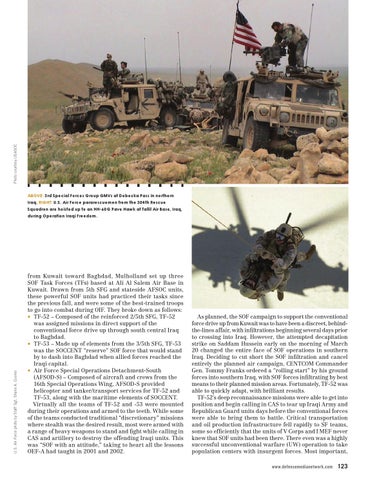Photo courtesy USASOC
ABOVE: 3rd Special Forces Group GMVs at Debecka Pass in northern Iraq. RIGHT: U.S. Air Force pararescuemen from the 304th Rescue Squadron are hoisted up to an HH-60G Pave Hawk at Tallil Air Base, Iraq,
U.S. Air Force photo by Staff Sgt. Shane A. Cuomo
during Operation Iraqi Freedom.
from Kuwait toward Baghdad, Mulholland set up three SOF Task Forces (TFs) based at Ali Al Salem Air Base in Kuwait. Drawn from 5th SFG and stateside AFSOC units, these powerful SOF units had practiced their tasks since the previous fall, and were some of the best-trained troops to go into combat during OIF. They broke down as follows: • TF-52 – Composed of the reinforced 2/5th SFG, TF-52 was assigned missions in direct support of the conventional force drive up through south central Iraq to Baghdad. • TF-53 – Made up of elements from the 3/5th SFG, TF-53 was the SOCCENT “reserve” SOF force that would stand by to dash into Baghdad when allied forces reached the Iraqi capital. • Air Force Special Operations Detachment-South (AFSOD-S) – Composed of aircraft and crews from the 16th Special Operations Wing, AFSOD-S provided helicopter and tanker/transport services for TF-52 and TF-53, along with the maritime elements of SOCCENT. Virtually all the teams of TF-52 and -53 were mounted during their operations and armed to the teeth. While some of the teams conducted traditional “discretionary” missions where stealth was the desired result, most were armed with a range of heavy weapons to stand and fight while calling in CAS and artillery to destroy the offending Iraqi units. This was “SOF with an attitude,” taking to heart all the lessons OEF-A had taught in 2001 and 2002.
As planned, the SOF campaign to support the conventional force drive up from Kuwait was to have been a discreet, behindthe-lines affair, with infiltrations beginning several days prior to crossing into Iraq. However, the attempted decapitation strike on Saddam Hussein early on the morning of March 20 changed the entire face of SOF operations in southern Iraq. Deciding to cut short the SOF infiltration and cancel entirely the planned air campaign, CENTCOM Commander Gen. Tommy Franks ordered a “rolling start” by his ground forces into southern Iraq, with SOF forces infiltrating by best means to their planned mission areas. Fortunately, TF-52 was able to quickly adapt, with brilliant results. TF-52’s deep reconnaissance missions were able to get into position and begin calling in CAS to tear up Iraqi Army and Republican Guard units days before the conventional forces were able to bring them to battle. Critical transportation and oil production infrastructure fell rapidly to SF teams, some so efficiently that the units of V Corps and I MEF never knew that SOF units had been there. There even was a highly successful unconventional warfare (UW) operation to take population centers with insurgent forces. Most important, www.defensemedianetwork.com
123
